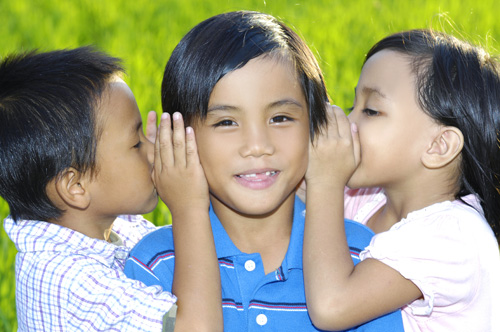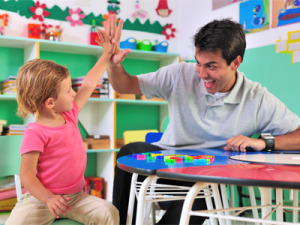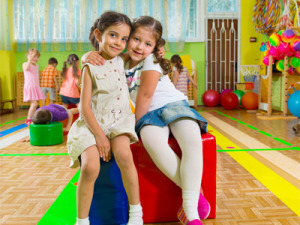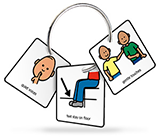How can teachers help young children learn expected behaviors?
Page 4: Teaching Classroom Rules
 Developing and displaying rules is an important first step for helping children understand what is expected of them in the classroom. However, if children are to learn the rules and follow them every day in a variety of settings, teachers must intentionally and systematically teach both the rules and the expected behaviors. Teachers can do this by defining the rules, involving children in the process, reviewing them with the children, and providing additional supports if needed.
Developing and displaying rules is an important first step for helping children understand what is expected of them in the classroom. However, if children are to learn the rules and follow them every day in a variety of settings, teachers must intentionally and systematically teach both the rules and the expected behaviors. Teachers can do this by defining the rules, involving children in the process, reviewing them with the children, and providing additional supports if needed.
intentionally and systematically teach
The act of being thoughtful and purposeful about designing activities and providing instruction, and doing so in a methodical manner.
Clearly Defining the Rules
- Define the rules using clear, child-friendly language (i.e., simple, concrete; “We clean up” instead of “We clean up after we make messes with paint and glue”).
- Provide examples and non-examples when defining the rules to ensure that children understand them. For example, during group time the teacher might ask the children to role-play using “inside voices” and “outside voices.”
Involving Children
- Involve children in discussions about the rules and why they are important. A teacher might ask, “Why do you think it is important to go down the slide feet-first?” Sometimes, children won’t agree with or understand the purpose of the classroom rules; for this reason, it is important to discuss why these rules are in place.
- Use diverse methods to teach children the rules. This includes discussions, role-plays, puppets, books, songs, and technology. A teacher might organize a small-group activity in which two puppets act out a non-example of a rule (e.g., running instead of using walking feet) and ask children to identify the rule that is not being followed, then give examples of alternative ways to behave. A teacher could also help children identify whether rules are being followed in a story that is read to the class. A teacher can show short videos related to the rules on a tablet and have children respond to them.
- Have the children contribute to a classroom rules book in which each rule is demonstrated (in the form of a photograph) by children in the classroom. To personalize the book, the children can write their names beneath their pictures. Click here for an example of a classroom rules book.
“Our Classroom Rules Book” is a virtual “flip book.” Clicking on the right or left edge of a page will move you forwards or backwards in the book.(There are 5 double-pages in the book.)
The book begins with the front cover titled “Our Classroom Rules.”
Turning to the first page it begins with the rule “Listen when others talk” underneath this classroom rule is two pictures of children following this rule. The first picture is of the whole class during circle time looking at the teacher and listening attentively. The second picture is of Hudson and Jeremiah playing together as Hudson is listening to Jeremiah.
Turning to the second page you see the next classroom rule “Use kind words and gentle touches” underneath this rule is two pictures of children following this rule. The first picture is of Brynlee and Violet sitting and talking together outside on the playground. The second picture is of a small group of children giving a gentle group hug.
Turning to the third page you see the next classroom rule “Follow directions” underneath this rule is two pictures of children following the rule. The first picture is of the children following the direction to independently work on an art activity, the teacher is watching from her desk. The second picture is of Kennedy and Patrick cleaning up toys.
Turning to the fourth page you see the next classroom rule “Use inside voices in school” underneath this rule is two pictures of children demonstrating the rule. The first picture is of Kayden and Micah bringing their index finger to their lips and saying “shh.” The second picture is Piper doing the same.
Turning to the fifth page you see the next classroom rule “Use walking feet” underneath this rule is two pictures of children following the rule. The first picture is of a group of students walking into the school. The second picture is of Ariel walking.
(Close this panel)
Reviewing and Checking Often
- Review classroom rules daily during large-group times. This provides children with regular reminders about the rules and helps ensure that adults are consistent in how they talk about rules and behaviors.
- Check periodically to see whether children understand the rules. This can be done through many of the activities listed above. For example, if the teacher is using a puppet to demonstrate inappropriate behavior, and the child cannot identify the rule the puppet should be following, this is a signal that he or she may need additional instruction.
- Use scripted stories to assist children in understanding rules. Teachers can also use scripted stories to address an individual child’s challenging behaviors. These can be created in hard copy or electronic format using a tablet or computer.
x
scripted story
glossary
A scripted story is presented in book form with illustrations and minimal text on each page. In this example, only the text for each page is provided. In an actual book, illustrations would accompany each page.
Bennett Can Follow Directions (cover page)
Page 1: My name is Bennett. I go to pre-k, and my teachers are Mrs. White and Mrs. Ryan.
Page 2: I do a lot of fun things at pre-k, like have group time, go to centers, and play outside.
Page 3: At pre-k, we have to follow our classroom rules.
Page 4: I can follow these rules:
I can listen when others talk.
I can use walking feet.
I can use an inside voice in the school.
I can use kind words and gentle touches.Page 5: The last rule is to follow directions. That rule is hard! It can mean a lot of different things:
Page 6: When I arrive in my classroom in the morning, I have to follow a lot of directions! First, I sit on my spot on the carpet. When my name is called, I put my folder in the basket by the door. Then I walk to the cubbies. If I have a coat on, I put my coat and my backpack in my cubby. Then I sit down on the carpet.
Page 7: At group time, following directions means I should sit crisscross on my spot. I should keep my hands to myself. If I want to talk, I should raise my hand. I should look at Mrs. White and listen to what she says. When I follow directions at group time, I have fun singing, dancing, and learning!
Page 8: I have to follow directions at centers, too! I can play at the center if there is a Velcro spot open on the board. When I follow directions at centers, I have fun learning and playing!
Page 9: Even though it can be hard, I have to remember to follow the rules and follow directions. When I follow the rules and directions, school is more fun!
In the first video below, the teacher involves children in reviewing the rules and in demonstrating examples and non-examples. In the second, the teacher uses a large-group activity to evaluate children’s understanding of the rules.
Transcript: Reviewing the Rules
Teacher: Okay, let’s do our classroom rules. Are you guys ready?
Children: Yes.
Teacher: Okay, I need some helpers. Let me see. Sean, what’s our first classroom rule?
Sean: Walking feet.
Teacher: We use walking feet. Show me walking feet. Show me running. Where can you run?
Children: Outside.
Teacher: Outside. Good job. Deanna, what’s another classroom rule?
Deanna: Inside voices.
Teacher: Inside voices. Say “hello” really, really loud.
Children: Hello!
Teacher: Where can you use that voice?
Children: Outside.
Teacher: Outside. Say “hello” using your inside voice.
Children: Hello.
Teacher: Say “hello” and don’t make a sound.
Children: Hello.
Teacher: Deja, what’s another classroom rule?
Deja: Use gentle touches.
Teacher: Gentle touches. What would be a gentle touch?
Child: This will.
Teacher: A pat on the back, very good. How about a shaking of hands? Say “good morning.”
Children: Good morning.
Teacher: Good morning. Or a hug. That’s right. Good job or hold hands. Let’s say our rule together. Haley, will you point? Okay, point to them as we say them. At the very top. Let’s say them together.
Teacher and children: We use walking feet. We have inside voices. We use gentle touches. We take turns, and we clean up.
Transcript: Evaluating Children’s Understanding of the Rules
Teacher: I have a picture of a friend who’s running in the classroom, using his feet for running.
Child: Use feet for walking.
Teacher: Guys, is that a stop…
Child: Stop.
Teacher: …or is that a go?
Children: A stop.
Teacher: It’s a stop. Can you show me your red side?
Children: Stop.
Teacher: That’s a stop. I see some red. Very good. That’s a stop. I have a friend, and you know what? They want to get through, so what he does is he kicks his friend’s leg out of the way. Is kicking a go, or is kicking a stop?
Children: It’s a stop.
Teacher: Kicking is a stop. We use our feet for…
Children: Walking.
Teacher: Walking. What are “go” things, and what are…
Children: Stop things.
Teacher: …what are “stop” things? Now I have one other thing…
Providing Individualized Support
In addition to the more-universal strategies for teaching rules (described above), teachers might need to provide some children with more individualized instruction and support, such as:
- Additional one-on-one instruction and reminders about the rules
-
Copies of the visual supports to serve as cues and reminders of the rules. Sometimes, it is helpful for the teacher to have a small, portable visual (e.g., key ring, a lanyard, small board) that she can pull out to remind the child of the rules when in different locations. Alternately, the teacher can provide the child with a copy of the visual to carry.
Credit
The Picture Communications Symbols ⓒ1981-2014 by Mayer-Johnson LLC. All Rights Reserved Worldwide. Used with permission.
- More specific definitions and visuals to help children understand what it means to comply with the rules.
For a child who had difficulties using gentle touches, the teacher created additional visuals that showed different types.
Using Gentle Touches
(gentle touches can be high-fives, a pat on the back, holding hands, hugs)




Hug
(but ask 1st)
For Your Information
Teachers must consider each child’s needs and abilities when teaching the classroom rules. Examples include:
- For a child who has a visual impairment, a teacher might make the visual larger or provide objects for the child to manipulate.
- For a child who has a receptive language delay, the teacher might use short, simple language (e.g., “Nice walking, Kelly!” instead of “Kelly, I noticed you used your walking feet in the hallway.”)
Amanda Peirick and Mary Louise Hemmeter offer more information about teaching classroom rules.

Amanda Peirick, MEd
Lead Teacher, Susan Gray School
Nashville, TN
Systematically teaching rules (time: 3:30)

Mary Louise Hemmeter, PhD
Nicholas Hobbs Chair
in Special Education and Human Development
Vanderbilt University
Systematically teaching rules (time: 2:15)
Transcript: Amanda Peirick, MEd
Systematically teaching rules
I think that reviewing and going over them daily is very important. When I was a young teacher, I kind of made the mistake of “I taught my rules! Now let’s go.” And then a few months into the year, I’m, like, “Where’s all this behavior coming from?” So I learned after awhile that to keep these at the front of our mind and for kids to really understand what they are, that we have to go over them over and over and over again and sometimes you start to feel, like, “I have said this 4,000 times. How do they not know this at this point?” But then you realize when you stop giving those reminders, that it’s just not something they’re thinking about on a regular basis. So reviewing them daily from the day you start school till the end of the year is really important for these kids. In pre-K we teach our letters, our numbers, our shapes, our colors, and we do it very systematically because these are things that kids need to know. We need to teach behavior just as systematically. A lot of times, we just think kids understand, they understand what they’re supposed to do. Everybody knows you come to circle time and you sit, and you’re supposed to listen to your teacher. But what we found is that kids don’t always know, and that’s when we start to see the challenging behaviors. We need to be really systematic about teaching these things also.
Teaching these rules and expectations is just as important as teaching the academic skills. I like to think about it in the same way so that I have a way that I introduce these skills in large-group activities that everybody is kind of learning what the behaviors are. And then we give kids chances to practice following the rules or what the rules look like or knowing what these rules are throughout the day. Then we can move on to supporting them, maintaining and generalizing these behaviors. Some ways that we do that, let’s see, we have lots of large-group games that we develop about what should our classroom rules be. We want to involve kids in developing these.
As a teacher, we definitely display our self as an authority figure, but we want to get their buy-in and so we want to talk with them about why are we having these rules and what makes it important? In my class, we do a lot of role-playing around behavior expectations. I’ve started to use puppets lately, which I think is really engaging for the kids. We play out different scenarios of our behavior and what happens when we’re using things that are rules and aren’t rules. We have developed a social story in my class that we kind of use to introduce the rules. And in the story, we put pictures of the kids following each rule. So this is what it looks like when we’re using our walking feet. This is what it looks like when we’re using our gentle touches. This is what it looks like when we’re using nice words. That goes in the book center and they get to read it throughout the day, and they love seeing pictures of themselves following the rules. We created a rule song in our classroom. Music is a really engaging way to teach new things to kids sometimes and then to be able to review it over and over again. We developed a song that we sing every day in circle time that goes over what each rule expectation is so that they can have that reminder on a daily basis. We also like to practice a lot of examples and non-examples of what the rules are. Those are some sort of structured things that we do. It’s really important throughout the day to be recognizing these things when they’re happening, both when the kids are participating and following the rules, but then also if you see a child who’s not using a rule to be able to go and have a conversation about that. Remember we use our gentle touches. Why is it important to use our gentle touches, and what happens when we don’t, kind of, throughout the day on an ongoing basis.
Transcript: Mary Louise Hemmeter, PhD
Systematically teaching rules
One thing about rules and expectations is that often teachers develop rules and expectations but aren’t systematic in how they teach children the rules and expectations. And so there are nice posters, and we talk about them for a few weeks at the beginning of the year. What we know is that it takes time for children to learn anything, and just like it takes them time to learn how to read or write or talk or walk, it’s going to take them time to learn what the expectations are. And so, I think, often when children aren’t engaging in expectations in classrooms, it’s because we haven’t been systematic about how we teach them. When we’re systematic about how we teach them and three-fourths of the classroom is now doing them and a fourth isn’t, often we think if we just keep teaching it in the same way they’ll learn. And often the children who are engaging in problem behaviors, who aren’t engaging in the expectations, are children who are going to need more individualized instruction around that expectation, who are going to need more practice with the expectations, who are going to need more feedback about the expectations. And often we view those children as having challenging behaviors when we really haven’t been systematic enough about teaching them what to do in place of the problem behavior. It will be important when you’re teaching rules and expectations to think not only about how you’re teaching those to the whole class but how you’re teaching them to individual children and realizing that what you do for the whole class is probably not going to be enough for some children, and that you may need to think about more individualized ways of teaching the rules and expectations to children who have more severe problem behavior. But that doesn’t mean that those are children who need something beyond that individualized instruction. That might just mean more instruction, might mean more-frequent instruction, might be mean more-systematic instruction, more-intense instruction to really help them learn the routines and expectations of the classroom.
Visual supports (time: 4:03)
Scripted stories (time: 2:06)
Transcript: Amanda Peirick, MEd
Visual supports
Visuals are one of the most amazing teaching tools in the world. I think for a lot of reasons they’re essential to teaching lots of skills and especially rules and expectations. One of the reasons is that it’s really helpful for kids processing information. We use a lot of words throughout the day, and we know that kids are only processing a small percentage of what we’re saying when they’re three, four, and five years old. It’s really important for them to have that visual that’s constant, that can help remind them and help them understand what our words mean. There’s this interesting phenomenon that you can’t argue with a visual. Sometimes, if a teacher is giving a direction, it’s really easy for a child to want to do something different, but if it’s a visual the visual is constant. It can’t change what it’s asking you to do, and it’s always going to be there. I think that’s comforting for kids: “I know what this means and I understand it, and I can follow that rule.” It’s also really helpful to use visuals to be able to redirect behavior without stopping what you’re doing. A lot of times, you’re teaching a really great activity, and if you have to stop and give a rule reminder, it stops the flow. The other kids are not able to attend as much anymore. But if you have visuals handy, you can just show a visual. A lot of times, that’s all a kid needs. You can keep doing what you are doing and keep being able to teach and moving forward with the activity that you were participating in.
In my classroom, we have a large poster of our school-wide expectations, and each expectation has the words and a visual of what that expectation is, and then we also have a page of each classroom rule, too. We have four classroom rules that we use, and each rule has its own poster in the classroom. Those are posted at our circle time area, which is also our block center. It’s visual throughout the day. Kids can go over there and refer to them if they need it. We have created some more-specific rules for activities. We have some rules for circle time that help children know what’s the best way I can be a listener or a learner during circle time, what kind of a voice do I use, what do my legs need to look like? Those things we keep on Velcro strips around the room, so that they’re easily accessible all the time, and the teachers can just pull them off and use them as a reminder. One thing that we’ve also found really helpful is that we did a small group where our kids were able to draw pictures of themselves following the rules. So on our rules visuals around the classroom, the kids have participated in making those and there are pictures that they have drawn, and they wrote their names on the rules, too. So I think that what we found is that when you have these things in place, we see a really big decrease in a lot of challenging behavior in the classroom.
There are still some kids that these rules are not meaningful, and they’re still not understanding what these concepts are. There’s a lot of different things that that we can do around that, but it goes on a child-by-child basis. If the child is having a hard time following a rule or having some challenging behavior, we first try and think about why. What is this child communicating to me by this behavior by not being able to follow the rule? Then we can develop a plan for what do your individuals visuals need to look like. Sometimes, kids don’t understand. The visuals in my classroom are usually line drawings. I start with that. Sometimes then we’ll take pictures and put them in classroom book. Some kids don’t understand what the line drawings mean. If I find that a child is not really following the rules, I’ll take pictures of that child following the rules throughout the day and put that in a social story or a book or even a keychain that they can have on them at all times that you can just refer to. “Oh, remember, we have to use our walking feet now.” That’s been helpful throughout the day. It might be helpful to have some system where these children are working for some reward for following the rules. They might need a little extra support and understanding what this rule is and being taught how to actually do it in the classroom. Sometimes it can be, “Hey, you’re working to use your nice hands throughout the day today. Every time I see you using your nice hands, maybe we get a sticker on a chart or maybe we get something special that’s really going to help you understand what it looks like when you’re doing this rule and that makes it meaningful to you.”
Transcript: Mary Louise Hemmeter, PhD
Scripted stories
We use scripted stories as a way to teach children the concepts around appropriate behavior, around routines, or around expectations. You can use scripted stories that you write for the whole classroom that introduces what the expectations are of the classroom, but does it through a story and uses visuals. The visuals can be the same visuals that are in the classroom to help remind children about the rules and expectations. We also often use scripted stories to teach individual children who are having difficulty with either an expectation or a rule, or difficulty with the routine in the classroom, more-appropriate ways to engage in that routine or those expectations. One of the benefits of doing that with individual children is that you can use visuals that are actually the child engaging in the routine, and so just making the scripted story is an opportunity to prompt the child through the routine. Then the pictures in the book are the child actually engaging in the routine. Scripted stories can be used for a whole lot of things, like helping children understand arrival in the classroom or leaving the classroom, or what to do in circle time, or how you’re nice to your friends, any of those kinds of things. But it’s also important to realize that scripted stories are just a tool for introducing those concepts to children, and that using the scripted story in the absence of good prompting and scaffolding and reinforcing in the actual context is probably not going to be effective. For scripted stories to be most effective, that’s the way you introduce it to the child. That’s the way you remind the child of what the expectations are or the routine is, and then actually helping the child practice what’s in that scripted story in the real activity or routine that they need to use it will be important to really teaching the child how to do it.
Revisit Mrs. Rodriguez's Classroom
 Mrs. Rodriguez realizes that simply displaying the new rules won’t be enough to get her children to follow them. Instead, she is going to have to teach the rules just as she had taught every other concept all year, intentionally and systematically.
Mrs. Rodriguez realizes that simply displaying the new rules won’t be enough to get her children to follow them. Instead, she is going to have to teach the rules just as she had taught every other concept all year, intentionally and systematically.
With that in mind, Mrs. Rodriguez examines her schedule and pencils in a time each day to talk about classroom rules. During this time, she offers a variety of activities, such as role-plays, puppet shows, and think-pair-share, to help her children better understand the rules. During each activity, they discuss examples of following the classroom rules and examples of not following the classroom rules. Jerry is especially excited about the opportunity to demonstrate examples of not following the rules.
Think-Pair-Share
glossary
